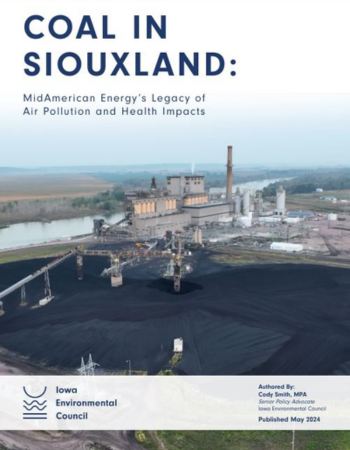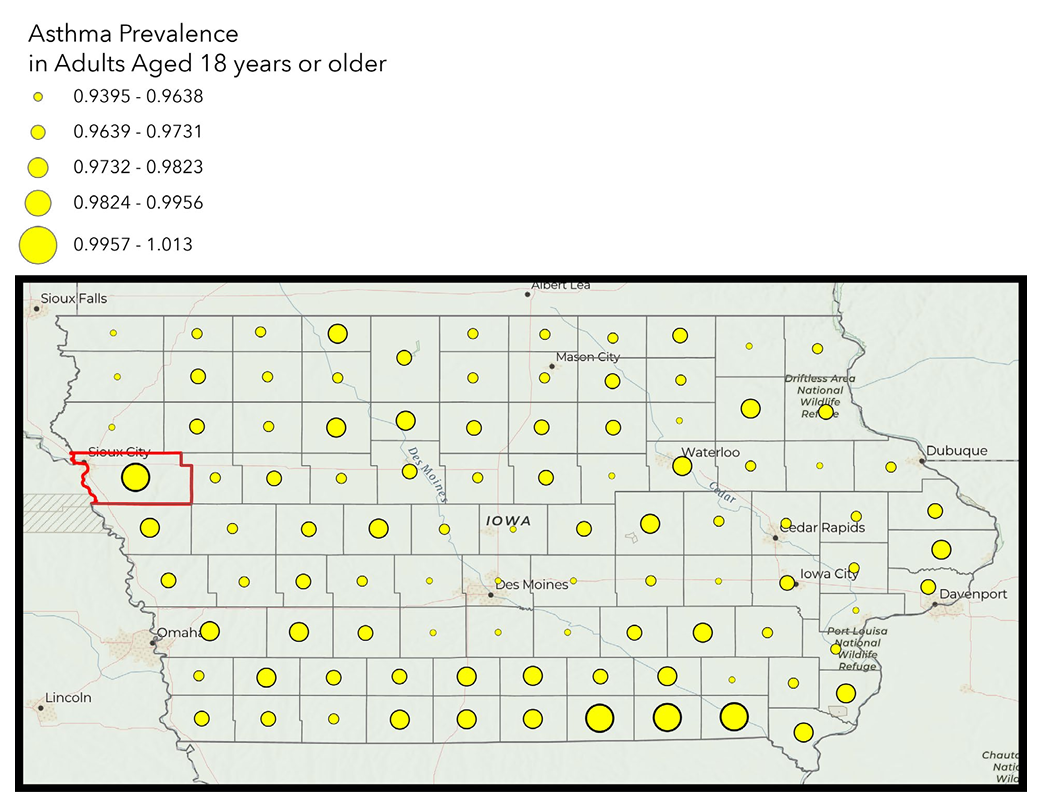New health report finds increased asthma rates, lung disease in Iowa communities with coal plants
posted
on Tuesday, May 7, 2024
in
Energy News
Report from Iowa Environmental Council and health partners finds increased asthma rates in communities with coal plants
 Des Moines, IA — A new report from the Iowa Environmental Council, released on World Asthma Day, examines the relationship between pollution from coal plants and lung disease in Woodbury County. Written in partnership with public health experts from organizations including the American Lung Association, Physicians for Social Responsibility, and the Winnebago Tribe of Nebraska’s Winnebago Comprehensive Healthcare System, Coal in Siouxland: MidAmerican Energy's Legacy of Air Pollution and Health Impacts highlights how two coal-fired power plants in northwest Iowa operated by MidAmerican Energy harm the health of Siouxland, the multi-state, three county region surrounding Sioux City, IA.
Des Moines, IA — A new report from the Iowa Environmental Council, released on World Asthma Day, examines the relationship between pollution from coal plants and lung disease in Woodbury County. Written in partnership with public health experts from organizations including the American Lung Association, Physicians for Social Responsibility, and the Winnebago Tribe of Nebraska’s Winnebago Comprehensive Healthcare System, Coal in Siouxland: MidAmerican Energy's Legacy of Air Pollution and Health Impacts highlights how two coal-fired power plants in northwest Iowa operated by MidAmerican Energy harm the health of Siouxland, the multi-state, three county region surrounding Sioux City, IA.
“The data is clear that Woodbury County has the highest asthma rate in the state of Iowa,” says Cody Smith, MPA, Senior Policy Advocate for the Iowa Environmental Council. “Pollution from coal plants makes our communities sicker and drives worse health outcomes, especially for communities of color and Iowans of low-income.”
The report, and its accompanying one-page summary, demonstrate that the two coal plants have been associated with causing at least 1,400 premature deaths since 1999 and the region’s rates of asthma and lung cancer outpace statewide averages.
“Emissions from coal plants pose a serious threat to public health in Iowa,” says John Rachow, MD, PhD, Past President of Physicians for Social Responsibility. “In low-income communities with limited access to preventative healthcare, this pollution can increase expensive emergency room visits and exacerbate existing health conditions, including asthma, chronic obstructive pulmonary disease (COPD), and various forms of heart disease.”
Woodbury County, home to Sioux City, outpaces the state’s average number of asthma-related emergency department visits. About 12% of people in the region, approximately 17,000 residents, are currently living in poverty.

“Clean air is essential to fostering community health and to ensuring that those who are the most vulnerable to pollution, including the elderly and young children, can live happy, healthy lives,” says David Osterberg, M.S., Emeritus Clinical Professor at the Department of Occupational and Environmental Health, University of Iowa. “The serious health impacts outlined in this report represent the lived experience of everyday Iowans. We can no longer ignore the outsized impact of coal-fired electricity production on Iowans’ health and wellbeing.”
Operations began at Siouxland’s first coal plant in 1964, and the two remaining plants emit thousands of tons of pollutants each year, including sulfur dioxide (SO2), nitrogen oxides (NOx), fine particulate matter (PM), mercury, and other hazardous air pollutants (HAPs) and volatile organic compounds (VOCs). These pollutants contribute to the development of heart and lung diseases and increase the likelihood of respiratory and cardiac symptoms.
“The data in this report raise troubling questions for us and should be concerning to all Iowans and to MidAmerican Energy,” says Smith. “Siouxland residents deserve to breathe clean air that doesn’t make them sick. These findings should be a wakeup call for MidAmerican Energy to take responsibility for how their pollution is harming Iowans and work quickly to act as a responsible corporate neighbor.”
###
View the full report here
View the quick look
Watch the May 7, 2024, press conference here:
- carbon pollution
- coal
- environmental justice
- public health